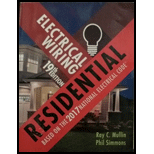
- a. What circuit supplies the workshop lighting? ________________
- b. What circuit supplies the plug-in strip over the workbench? ________________
- c. What circuit supplies the freezer receptacle? ________________
(a)
Mention the type of circuit that is used to supply the workshop lighting.
Answer to Problem 1R
The circuit used to supply the workshop lighting is A17.
Explanation of Solution
Discussion:
Refer to Figure 18-1 in the textbook that shows the conduit layout for workshop. In this layout, the lighting circuit is supplied by the branch circuit A17. In addition to supply the lighting, the circuit A17 also feeds the ceiling exhaust fan and chime transformer.
Conclusion:
Thus, the circuit used to supply the workshop lighting is A17.
(b)
Mention the type of circuit that is used to supply the plug-in strip over the workbench.
Answer to Problem 1R
The circuit used to supply the plug-in strip receptacles over the workbench is A18.
Explanation of Solution
Discussion:
Refer to Figure 18-1 in the textbook that shows the conduit layout for workshop. The plug-in strip receptacles and the receptacles connected to the right of the main panelboard are supplied with circuit A18. The receptacles mounted in an unfinished basement are protected with GFCI protection and accomplished by installing GFCI receptacles or GFCI circuit breakers in panelboard A.
Conclusion:
Thus, the circuit used to supply the plug-in strip receptacles over the workbench is A18.
(c)
Mention the type of circuit that is used to supply the freezer receptacle.
Answer to Problem 1R
The circuit used to supply the freezer receptacle is A13.
Explanation of Solution
Discussion:
Refer to Figure 18-1 in the textbook that shows the conduit layout for workshop. In this layout, the freezer single receptacle is supplied with circuit A13. Refer to Figure 18-9 in the textbook that shows the outlet boxes (a handy box) used for the freezer receptacles.
Conclusion:
Thus, the circuit used to supply the freezer receptacle is A13.
Want to see more full solutions like this?
Chapter 18 Solutions
ELECTRICAL WIRING:RESIDENT.-TEXT (PB)
Additional Engineering Textbook Solutions
Thinking Like an Engineer: An Active Learning Approach (4th Edition)
SURVEY OF OPERATING SYSTEMS
Mechanics of Materials (10th Edition)
Problem Solving with C++ (10th Edition)
Vector Mechanics For Engineers
Elementary Surveying: An Introduction To Geomatics (15th Edition)
- An AM modulation waveform signal:- p(t)=(8+4 cos 1000πt + 4 cos 2000πt) cos 10000nt (a) Sketch the amplitude spectrum of p(t). (b) Find total power, sideband power and power efficiency. (c) Find the average power containing of each sideband.arrow_forwardCan you rewrite the solution because it is unclear? AM (+) = 8(1+ 0.5 cos 1000kt +0.5 ros 2000ks) = cos 10000 πt. 8 cos wat + 4 cos wit + 4 cos Wat coswet. -Jet jooort J11000 t = 4 e jqooort jgoort +4e + e +e j 12000rt. 12000 kt + e +e jooxt igoo t te (w) = 8ES(W- 100007) + 8IS (W-10000) USBarrow_forwardCan you rewrite the solution because it is unclear? AM (+) = 8(1+0.5 cos 1000kt +0.5 ros 2000 thts) = cos 10000 πt. 8 cos wat + 4 cos wit + 4 cos Wat coswet. J4000 t j11000rt $14+) = 45 jqooort +4e + e + e j 12000rt. 12000 kt + e +e +e Le jsoort -; goon t te +e Dcw> = 885(W- 100007) + 8 IS (W-10000) - USBarrow_forward
- Can you rewrite the solution because it is unclear? Q2 AM ①(+) = 8 (1+0.5 cos 1000πt +0.5 ros 2000kt) $4+) = 45 = *cos 10000 πt. 8 cos wat + 4 cosat + 4 cos Wat coswet. j1000016 +4e -j10000πt j11000Rt j gooort -j 9000 πt + e +e j sooort te +e J11000 t + e te j 12000rt. -J12000 kt + с = 8th S(W- 100007) + 8 IS (W-10000) <&(w) = USB -5-5 -4-5-4 b) Pc 2² = 64 PSB = 42 + 4 2 Pt Pc+ PSB = y = Pe c) Puss = PLSB = = 32 4² = 8 w 32+ 8 = × 100% = 140 (1)³×2×2 31 = 20% x 2 = 3w 302 USB 4.5 5 5.6 6 ms Ac = 4 mi = 0.5 mz Ac = 4 ५ M2 = =0.5arrow_forwardA. Draw the waveform for the following binary sequence using Bipolar RZ, Bipolar NRZ, and Manchester code. Data sequence= (00110100) B. In a binary PCM system, the output signal-to-quantization ratio is to be hold to a minimum of 50 dB. If the message is a single tone with fm-5 kHz. Determine: 1) The number of required levels, and the corresponding output signal-to-quantizing noise ratio. 2) Minimum required system bandwidth.arrow_forwardFind Io using Mesh analysisarrow_forward
- FM station of 100 MHz carrier frequency modulated by a 20 kHz sinusoid with an amplitude of 10 volt, so that the peak frequency deviation is 25 kHz determine: 1) The BW of the FM signal. 2) The approximated BW if the modulating signal amplitude is increased to 50 volt. 3) The approximated BW if the modulating signal frequency is increased by 70%. 4) The amplitude of the modulating signal if the BW is 65 kHz.arrow_forwardAn FDM is used to multiplex two groups of signals using AM-SSB, the first group contains 25 speech signals, each has maximum frequency of 4 kHz, the second group contains 15 music signals, each has maximum frequency of 10 kHz. A guard bandwidth of 500 Hz is used bety each two signals and before the first one. 1. Find the BWmultiplexing 2. Find the BWtransmission if the multiplexing signal is modulated using AM-DSB-LC.arrow_forwardAn FM signal with 75 kHz deviation, has an input signal-to-noise ratio of 18 dB, with a modulating frequency of 15 kHz. 1) Find SNRO at demodulator o/p. 2) Find SNRO at demodulator o/p if AM is used with m=0.3. 3) Compare the performance in case 1) and 2).. Hint: for single tone AM-DSB-LC, SNR₁ = (2m²) (4)arrow_forward
 EBK ELECTRICAL WIRING RESIDENTIALElectrical EngineeringISBN:9781337516549Author:SimmonsPublisher:CENGAGE LEARNING - CONSIGNMENT
EBK ELECTRICAL WIRING RESIDENTIALElectrical EngineeringISBN:9781337516549Author:SimmonsPublisher:CENGAGE LEARNING - CONSIGNMENT
